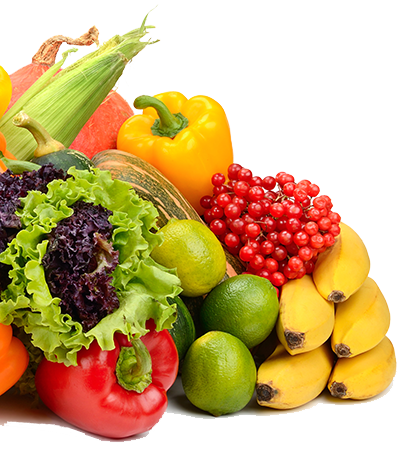Nutrition 101
Following a meal plan that is full of variety and Food Groups is essential for long term weight management- and good health. Below are some of our favorite nutrition tips by nutrient to get you started on a path to balanced nutrition. Just remember to start slow.
If you see a few different practices you would like to make your own, be sure to follow these steps to success:
- Start with short-term goals one month at a time.
- Only focus on 2-3 changes each month.
- Develop an incentive for every goal.
- Keep an ongoing log of your success on your calendar or in a diary.
- At the end of each month, reassess and recommit to new or redesigned goals.

Carbohydrates
Carbohydrates are the body's preferred source of energy. We obtain carbohydrates primarily from four Food Groups- Grains, Fruits, Vegetables and Dairy. To meet daily Grain Food Group goals, choose high fiber, whole grains. For the Fruit and Vegetable Food Groups, make varying color and texture the focus of your choices. Utilize the Vegetable Food Group the most, as vegetables provide about 2/3 less carbohydrates per serving than fruits. When working toward your Fruit Food Group goals, enjoy whole fruits and 100% fruit juice most often. In the Dairy Food Group, watch out for added sugar in milk, yogurt and frozen desserts. Remember, 4 grams sugar equals 1 teaspoon sugar. So, if your favorite yogurt's Nutrition Facts Label lists 24 grams sugar, you're eating roughly 3 teaspoons added sugar after accounting for about 12 grams of sugar coming naturally from the lactose in the milk. For cheese, choose lowfat versions, control portion sizes of high fat versions and use grated varieties for cheesy flavor without extra fat.
Protein
Protein rebuilds tissues, maintains hormones and is found predominantly in the Proteins Food and Dairy Food groups. Protein is essential to eat, but should not make up the majority of what we eat. Since protein-rich food is often laden with fat, choose lean protein sources daily. Bake, broil, sauté and grill lean meat sources like fish, chicken and turkey without the skin, ground turkey breast and lean cuts of beef and pork. Incorporate plant-based proteins into meals on a daily basis with pulses (dried beans, peas, chickpeas and lentils), soy, tofu, nuts and seeds. Although nuts and seeds do contain fat, their fats are heart healthy. Simply control portion size of nuts so their calories don't affect your waistline.
Fats
Fat is used for insulation, temperature regulation and protection of organs. Just like protein, fat is necessary for our health but should not make up the majority of your meals. Make plant fats (canola oil, olive oil, avocados, nuts and seeds) and omega-3's from fish the main source of fat in your meals. Watch out for saturated fat and trans fats by limiting the amount of high fat meats, deep fried foods and desserts you eat on a regular basis. Eat at least two, 4-6 ounce servings of fish each week. Pregnant mothers and children should enjoy low mercury fish like salmon, light Albacore tuna, sardines, and herring most often.
Water, Vitamins & Minerals
Proper hydration and meeting vitamin and mineral goals on a daily basis will help you feel ready to tackle the day. Let thirst be your guide for staying hydrated with water, caffeine-free and low-sugar beverages. To fill in vitamin or mineral blanks from day-to-day, take a basic daily multivitamin with minerals.
Meal Planning
Planning your meals ahead of time is often the best way to achieve your nutrition goals. By eating on a regular schedule each day, you'll help curb cravings, control portion sizes and maintain energy.
Whether you're trying to maintain, lose or gain weight following the schedule below will help you meet your goals:
Breakfast Meal-
Made up of at least 4 Food Groups and provides a source of carbohydrates, protein and fat.
A.M. Snack-
A small quantity of food with carbohydrates, protein and fat to help meet Food Group goals.
Lunch Meal-
Made up of at least 4 Food Groups and provides a source of carbohydrates, protein and fat.
Mid-Day Snack-
A small quantity of food with carbohydrates, protein and fat to help meet Food Group goals.
Dinner Meal-
Made up of at least 4 Food Groups and provides a source of carbohydrates, protein and fat.
*Workout Snacks- If a workout session happens before a meal or snack is consumed, make sure to eat a small snack consisting of carbohydrates and protein beforehand. This snack will help you feel and perform your best. If a meal is not going to be consumed within an hour after the conclusion of a workout, make sure to follow up with a small snack predominantly consisting of carbohydrates and protein.
MyPlate
To learn what your calorie goals are for weight gain, meeting with a registered dietitian nutritionist for one-on-one coaching is your best bet. They will be able to take into consideration your medical history, likes and dislikes and develop a plan of success with you. To find a dietitian to work with, contact your local hospital or visit the Academy of Nutrition and Dietetics and click on “Find an Expert.”
In the meantime, MyPlate is a good starting point. MyPlate will estimate your average calorie need for maintaining, losing or gaining weight and show you how to achieve this goal one Food Group at a time. It was developed by the USDA as a revision of the old Food Guide Pyramid. The greatest aspect of MyPlate is that it can be tailored to meet most healthy adult's nutrition needs. Visit MyPlate.gov to learn more about MyPlate.


